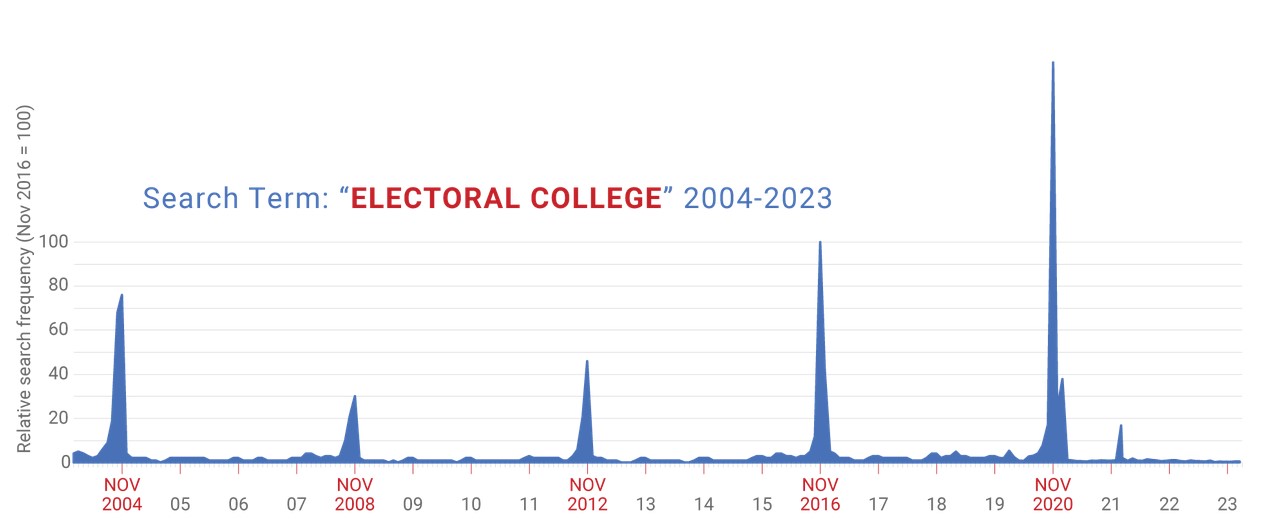What is the Electoral College?
The unaddressed Problem
Every 4 years, Google Trends shows a sharp spike in searches for“Electoral College”.

This spike peaks on a very specific date: Wednesday, the day after the general election. Why is this so?
If you found this page the day we posted it, or in the days after the presidential election, you are in good company. Most Americans do not understand how they elect their president.
At Election Lab, we believe everyone should understand the consequences of the Electoral College, and how it forces campaigns to tailor their strategies to win.
What is the Electoral College?
While you may believe you voted for Harris or Trump, that isn’t entirely accurate. Instead of directly voting for the president, voters actually choose electors, who will vote on their behalf. These electors then meet* a month later to cast their votes for President and Vice President. each state holds its own vote, and then… electors who then form the Electoral College and then the Electoral College vote for the president. There are 538 members of the Electoral College, meaning each candidate needs 270 votes to win the presidency.
How these electors are selected has evolved over time. Today, 48 states and Washington DC have a winner-take-all contest. That is, if Donald Trump wins the popular vote in Ohio, all 17 electors from Ohio come from his slate of electors. If he loses the popular vote, all of Kamala Harris’s slate of electors are chosen instead. As a candidate, you need to win whole states, or you receive no electoral votes.
Why are there 538 electors?
The number of Electors for each state is equal to the number of Senators (always 2) plus the number of Representatives from that state (from 1 to 52). As of 2024, the range of Electoral Votes for each state is from 3 to 54. The total number of Senators and Representatives in Congress is 535. So why do we have 538 Electors, and not 535? The answer is that Washington, DC, is also awarded 3 electors. Before 1964, American citizens who lived in Washington, DC, could not vote for president. This injustice was remedied by the Twenty-third Amendment to the Constitution.
Consequences of our System
What are Swing States?
Before a single vote for president is cast, we can be reasonably confident about which way many of the States will “swing”. For example, we can be pretty certain that California’s electoral votes will go to Harris and Tennessee’s will go to will vote for Trump. The states that could vote for either candidate are called swing states, and they are where candidates spend the majority of their time and energy. Candidates who don’t are putting themselves at a disadvantage because their energy is going to states that are unlikely to switch sides.
Disagreement with the popular vote
In most of our elections, the candidate who won the popular vote also won the electoral college, but that isn’t always the case. The most recent example is the 2016 election when Trump won 304 electoral college votes but had 2 million fewer votes. There are a few reasons for this disparity. The first is that each state has a minimum of 3 electoral votes. Small states like Wyoming and Vermont will end up pledging more electors per capita than big states like Texas and California. Additionally, because all the electors follow the popular vote in each state, the system acts as if the entire population voted in favour of that candidate.
Why do we still have it?
The Electoral College favours one side over another. The side that is benefiting will not be willing to remove it. Because the Electoral College is in the constitution, any changes would require a constitutional amendment to be agreed upon by both parties. Sometimes, both parties agree over bipartisan issues; however, because the Electoral College is good enough at following the popular vote, there isn’t enough momentum to change to a different system.